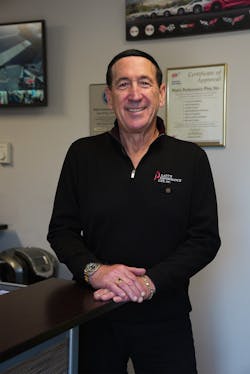Flying blind is an expression derived from the aviation world when World War II pilots who were unable to see the horizon would have to rely on their instincts and instruments to guide their aircraft. Today, it has come to mean anyone who does a job or runs a business solely relying on guesswork with the hope of achieving a successful outcome.
When Edwin Platt, owner of Platt’s Performance Plus, Inc. In Jamesburg, New Jersey, opened his shop in 1988, he was doing just that—piloting without a flight plan.
Backstory:
When Platt opened his shop, he was a solo operator. In those days, sophisticated customer relationship management software hadn’t been invented, so he ran the business on paper.
He had run a few other small businesses in the past, but none as detail-oriented as an auto repair shop. Platt recalls the day-to-day operations as being hectic, even after he did score his first computer.
“I was just by myself. I’d have a headset on at the time turning wrenches, doing the numbers,” he says. “(I was) looking at the numbers and mostly everything was on paper in the beginning. Then I got my first computer system, but still wasn't tracking numbers.”
Problem:
Platt’s inexperience with tracking numbers is a common problem many fledgling auto repair shop owners face. Rather than managing by the numbers, it’s an operation based on volume approach that doesn’t take into account external variables that affect the bottom line.
“My friend was my accountant at the time, and he looked at my books every month and told me if I was doing good or bad and gave me the numbers back that way. I really wasn't looking at the numbers by myself,” Platt says.
And what neither understood was how key performance indicators were the governing data points that auto repair shops relied on for success.
“I didn't know key performance indicators,” Platt says. “But then I got with ATI—Automotive Training Institute—in Maryland, and they started talking about running your business by the numbers and tracking different benchmarks that you have set up and that's what really got me on track to running the business; looking at numbers you need to do make money.”
Solution:
It wasn’t for lack of effort that Platt’s auto repair shop wasn’t as successful as it could have been. He was putting in the work, seeing financial counsel and even hired a management company before switching to ATI. There, he learned about optimizing his website to generate more traffic, discovered the power of participating in 20 groups and ultimately learned to run his business by the numbers—setting course before taking flight.
One area he noticed an immediate change in was when he began to track technician efficiency and its impact on his labor rate. He conducted an exercise by which he clocked how much time his technicians took between cars following a complete repair and that’s when understanding the data clicked.
"We clocked how long it takes to do this and how much time was being wasted ... and studied our time, our patterns, what we do to be more efficient. That was a big time saver to get my labor efficiency up because that's what I was trying to do. I was looking at why we're not billing the right hours. It’s because we weren’t working smart,” Platt says.
Aftermath:
Platt continues to be coached and has since gone on to become one of the top performing shops under ATI, being named the Top Shop in the $1-$2 million bracket and his shop has been recognized in the company’s Top 25 and Top 12 shops nationally in the program.
Today, his son is now running more of the day-to-day operations, something Platt attests that wouldn’t have been possible had he not learned to run his business by the numbers. Before understanding his KPI, he was unable to get away from his shop.
“I couldn't walk away. I was very hard to get away for a meeting,” Platt says.
Takeaway:
In teaching his son the business, he’s stressed the value of operating the shop using benchmarks and data points, something his son has taken to and excelled in doing.
“He's learned the numbers too and he knows the numbers really well,” Platt says. “He's doing really well for me. So, it's helping me be able to step back. I want to retire. I don't want to be here all my life.”
Last winter, Platt was not only able to walk away for a meeting, but he even left the shop behind to take a Colorado ski vacation. But make no bones about it, he watched the numbers from afar just to be sure.
“I can see everything that's going on and what my son's doing. I wasn't here for half the month and the shop ran great,” Platt says.





